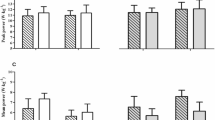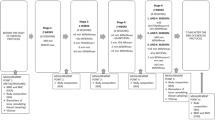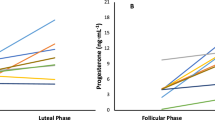Abstract
We investigated the short-term (1 hour-3 days) effects of a 45 minute run on calcium, parathyroid hormone, the carboxyterminal propeptide of type I procollagen (PICP), and the immunoactive carboxyterminal telopeptide of type I collagen in serum (ICTP) in young females. Fourteen healthy young women, aged 25.2 ± 0.6 years (mean ± SEM) with regular menstruations, participated. The test was outdoor jogging for 45 minutes at an intensity of 50% of VO2 max. Blood samples were collected 15 minutes before the test and 1, 24, and 72 hours after the test. The measured values were adjusted for changes in plasma volume. A significant decrease of ionized calcium was observed at 1 hour (P < 0.001) and 72 hours (P < 0.05) and a significant increase of parathyroid hormone (PTH) was noted 24 (P < 0.01) and 72 hours (P < 0.05) after the test. A significant decrease of PICP at 1 hour (P < 0.05) was followed by an increase after 24 (P < 0.01) and 72 hours (P < 0.001) and a significant increase in ICTP was noted at 24 and 72 hours (P < 0.05). A strong positive correlation was found between serum levels of PICP and ICTP (r = 0.55–0.84; P < 0.05) throughout the experiment. In conclusion, young females showed biochemical signs of increased bone collagen turnover and altered homeostasis of calcium and PTH after a single bout of moderate endurance exercise.
Similar content being viewed by others
References
Woo S, Knei S, Amiel D (1981) The effect of prolonged physical training on the properties of long bone: a study of Wolff’s law. J Bone Joint Surg 63A:780–787
Frost HM (1992) The role of changes in mechanical usage set points in the pathogenesis of osteoporosis. J Bone Miner Res 7:253–261
Lanyon LE (1992) Control of bone architecture by functioning loading. J Bone Miner Res 7(suppl 2):S369-S375
Snow-Harter C, Marcus R (1989) Exercise and regulation of bone mass. Bone 6:45–48
Nilsson BE, Westlin NE (1971) Bone density in athletes. Clin Orthop 77:179–182
Krølner B, Toft B, Tøndevold E (1983) Physical exercise as prophylaxis against involutional vertebral bone loss: a controlled trial. Clin Sci 64:541–546
Snow-Harter C, Bouxsein M, Lewis BT, Carter DR, Marcus R (1992) Effects of resistance and endurance exercise on bone mineral status of young women: a randomized exercise intervention trial. J Bone Miner Res 7:761–769
Taaffe DR, Snow-Harter C, Connolly DA, Robinson TL, Brown MD, Marcus R (1995) Differential effects of swimming versus weight-bearing activity on bone mineral status of eumenorrheic athletes. J Bone Miner Res 10:586–593
Friedlander AL, Genant HK, Sadowsky S, Byl NN, Glüer C-C (1995) A two-year program of aerobic and weight training enhances bone mineral density of young women. J Bone Miner Res 10:574–585
Krølner B, Toft B (1983) Vertebral bone loss: an unheeded side effect of therapeutic bed rest. Clin Sci 64:537–540
Law MR, Wald NJ, Meade TW (1991) Strategies for prevention of osteoporosis and hip fracture. BMJ 303:453–459
Sandler RB, Cauley JA, Hom DL, Sashin D, Kriska AM (1987) The effects of walking on the cross-sectional dimensions of the radius in postmenopausal women. Calcif Tissue Int 41:65–69
Ayalon J, Simkin A, Leichter J, Raifmann S (1987) Dynamic bone-loading exercises for postmenopausal women. Arch Phys Med Rehabil 68:280–283
Henderson SA, Graham HK, Mollan RAB, Riddoch C, Sheridan B, Johnston H (1989) Calcium homeostasis and exercise. Int Orthop 13:69–73
Ljunghall S, Joborn H, Roxin LE, Rastad J, Wide L, Åkerstrøm G (1986) Prolonged low-intensity exercise raises the serum parathyroid hormone levels. Clin Endocrinol 25:535–542
Salvesen H, Johansson AG, Foxdal P, Wide L, Piehl-Aulin K, Ljunghall S (1994) Intact serum parathyroid hormone levels increase during running exercise in well-trained men. Calcif Tissue Int 54:256–261
McSheehy PM, Chambers TJ (1986) Osteoblast-like cells in the presence of parathyroid hormone release soluble factor that stimulates osteoclastic bone resorption. Endocrinology 119:1654–1659
Jerome CP (1994) Anabolic effect of high doses of human parathyroid hormone (1–38) in mature intact female rats. J Bone Miner Res 9:933–942
Hodsman AB, Fraher LJ, Ostbye T, Adachi JD, Steer BM (1993) An evaluation of several biochemical markers for bone formation and resorption in a protocol utilizing cyclical parathyroid hormone and calcitonin therapy for osteoporosis. J Clin Invest 91:1138–1148
Eriksen EF, Charles P, Meisen F, Mosekilde L, Risteli L, Risteli J (1993) Serum markers of type I collagen formation and degradation in metabolic bone disease: correlation with bone histomorphometry. J Bone Miner Res 8:127–132
Charles P, Mosekilde L, Risteli L, Risteli J, Eriksen EF (1994) Assessment of bone remodeling using biochemical indicators of type I collagen synthesis and degradation: relation to calcium kinetics. Bone Miner 24:81–94
Mellko J, Niemi S, Risteli L, Risteli J (1990) Radioimmuno-assay of the carboxyterminal propeptide of human type I procollagen. Clin Chem 36:1328–1332
Risteli J, Melkko J, Niemi S, Risteli L (1991) Use of a marker of collagen formation in osteoporosis studies. Calcif Tissue Int 49(suppl):S24-S25
Kristoffersson A, Hultdin J, Holmlund I, Thorsen K, Lorentzon R (1995) Effects of short-term maximal work on plasma calcium, parathyroid hormone, osteocalcin and biochemical markers of collagen metabolism. Int J Sports Med 16:145–149
Salvesen H, Piehl-Aulin K, Ljunghall S (1994) Change in levels of the carboxyterminal propeptide of type I procollagen, the carboxyterminal cross-linked telopeptide of type I collagen and osteocalcin in response to exercise in well-trained men and women. Scand J Med Sci Sports 4:186–190
Virtanen P, Viitasalo JT, Vouri J, Väänänen K, Takala TES (1993) Effect of concentric exercise on serum muscle and collagen markers. J Appl Physiol 3:1272–1277
Thorsen K, Kristoffersson A, Lorentzon R (1996) The effects of brisk walking on markers of bone and calcium metabolism in postmenopausal women. Calcif Tissue Int 58:221–225
Fellman N (1992) Hormonal and plasma volume alterations following endurance exercise. A brief review. Sports Med 13:37–49
van Beaumont W (1972) Evaluation of hemoconcentration from hematocrit measurements. J Appl Physiol 32:712–713
Cann CE, Martin MC, Genant HK, Jaffe R (1984) Decreased spinal mineral content in amenorrheic women. JAMA 251: 626–629
Drinkwater BL, Nilson K, Chesnut CH III, Bremner WJ, Shainholtz S, Southworth MB (1984) Bone mineral content of amenorrheic and eumenorrheic athletes. N Engl J Med 311: 277–281
Price JS, Jackson B, Eastell R, Wilson AM, Russell RGG, Lanyon LE, Goodship AE (1995) The response of the skeleton to physical training: a biochemical study in horses. Bone 17: 221–227
Zaman G, Dallas SL, Lanyon LE (1992) Cultured embryonic bone shafts show osteogenic responses to mechanical loading. Calcif Tissue Int 51:132–136
Cheng MZ, Zaman G, Lanyon LE (1994) Estrogen enhances the stimulation of bone collagen synthesis by loading and exogenous prostacyclin, but not prostaglandin E2, in organ cultures of rat ulnae. J Bone Miner Res 9:805–816
Harter LV, Hruska KA, Duncan RL (1995) Human osteoblast-like cells respond to mechanical strain with increased bone matrix protein production independent of hormonal regulation. Endocrinology 136:528–535
Pead MJ, Skerry TM, Lanyon LE (1988) Direct transformation from quiecence to bone formation in the adult periosteum following a single brief period of bone loading. J Bone Miner Res 3:647–655
Raab-Mullen DM, Thiede MA, Petersen DN, Kimmel DB, Recker RR (1994) Mechanical loading stimulates rapid changes in periosteal gene expression. Calcif Tissue Int 55: 473–478
Nishiyama S, Tomoeda S, Ohta T, Higuchi A, Matsuda I (1988) Differences in basal and postexercise osteocalcin levels in athletic and nonathletic humans. Calcif Tissue Int 43: 150–154
Roach HI (1994) Why does bone matrix contain noncollagenous proteins? The possible roles of osteocalcin, osteonectin and bone sialoprotein in bone mineralisation and resorption. Cell Biol Int 18:617–628
Lukert BP, Higgins JC, Stoskopf MM (1986) Serum osteocalcin is increased in patients with hyperthyroidism and decreased in patients receiving glucocorticoids. J Clin Endocrinol Metab 62:1056–1058
Author information
Authors and Affiliations
Rights and permissions
About this article
Cite this article
Thorsen, K., Kristoffersson, A., Hultdin, J. et al. Effects of moderate endurance exercise on calcium, parathyroid hormone, and markers of bone metabolism in young women. Calcif Tissue Int 60, 16–20 (1997). https://doi.org/10.1007/s002239900179
Received:
Accepted:
Issue Date:
DOI: https://doi.org/10.1007/s002239900179




